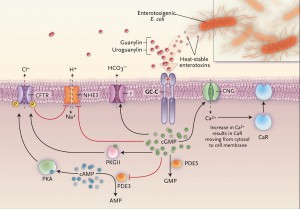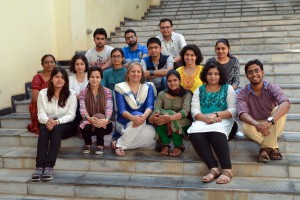MOLECULAR MECHANISMS OF CELL SIGNALLING
In order to survive, the cells in our body need to track their environment closely and respond quickly to changes. To achieve this, they use signalling pathways which help a cell tune in to the outside world. Understanding the molecular mechanisms underlying cell signalling is the focus of research in SandhyaVisweswariah’s lab.
 Errors in cell signalling pathways can have serious consequences, including causing diseases. One such disease that has attracted Visweswariah’s attention is called congenital secretory diarrhoea (CSD),a form of diarrhoea that manifests soon after birth. Her group, along with Austrian collaborators, has recently discovered that infants with CSD have mutations in a gene called GUCY2C.*This gene codes for the receptor guanylatecyclase C (GC-C), an important component of a signalling pathway in gut epithelial cells. Mutations in this gene can disrupt ion and water secretion from cells in the intestine, thus causing diarrhoea. “Many diseases are complex; they usually are the consequence of the interplay between multiple genes,” says Visweswariah, whose group has previously characterized a mutation in the same gene in hereditary diarrhoeal disease. “What made this [finding on CSD] a little special was the fact that the disease boiled down to a defect in a single gene.”
Errors in cell signalling pathways can have serious consequences, including causing diseases. One such disease that has attracted Visweswariah’s attention is called congenital secretory diarrhoea (CSD),a form of diarrhoea that manifests soon after birth. Her group, along with Austrian collaborators, has recently discovered that infants with CSD have mutations in a gene called GUCY2C.*This gene codes for the receptor guanylatecyclase C (GC-C), an important component of a signalling pathway in gut epithelial cells. Mutations in this gene can disrupt ion and water secretion from cells in the intestine, thus causing diarrhoea. “Many diseases are complex; they usually are the consequence of the interplay between multiple genes,” says Visweswariah, whose group has previously characterized a mutation in the same gene in hereditary diarrhoeal disease. “What made this [finding on CSD] a little special was the fact that the disease boiled down to a defect in a single gene.”
SandhyaVisweswariah’s group, along with Austrian collaborators,has recently discovered that patients with CSD have mutations in a gene called GUCY2C
 The current study was carried out in four unrelated children who suffered from CSD, using a combination of genetic and biochemical analyses. The researchers discovered that each of these patients had a different mutation in the GUCY2C gene which made the receptor GC-C highly sensitive to binding molecules. A hyperactive GC-C helps synthesize large quantities of cyclic guanosine monophosphate which sends the signalling pathway into overdrive, causing disease symptoms.
The current study was carried out in four unrelated children who suffered from CSD, using a combination of genetic and biochemical analyses. The researchers discovered that each of these patients had a different mutation in the GUCY2C gene which made the receptor GC-C highly sensitive to binding molecules. A hyperactive GC-C helps synthesize large quantities of cyclic guanosine monophosphate which sends the signalling pathway into overdrive, causing disease symptoms.
The road ahead, says Visweswariah, is to investigate if mutations in GUCY2C are also associated with other forms of diarrhoeal diseases, and to use the gene as a target for diagnosis and therapeutic intervention.
* Müller T, Rasool I, Heinz-Erian P, Mildenberger E,Hülstrunk C, Müller A, Michaud L, Koot BG, Ballauff A, Vodopiutz J, Rosipal S, Petersen BS, Franke A, Fuchs I, Witt H, Zoller H, Janecke AR, Visweswariah SS.2016. Congenital secretory diarrhoea caused by activating germline mutations in GUCY2C. Gut, 65(8):1306-1313




 Errors in cell signalling pathways can have serious consequences, including causing diseases. One such disease that has attracted Visweswariah’s attention is called congenital secretory diarrhoea (CSD),a form of diarrhoea that manifests soon after birth. Her group, along with Austrian collaborators, has recently discovered that infants with CSD have mutations in a gene called GUCY2C.*This gene codes for the receptor guanylatecyclase C (GC-C), an important component of a signalling pathway in gut epithelial cells. Mutations in this gene can disrupt ion and water secretion from cells in the intestine, thus causing diarrhoea. “Many diseases are complex; they usually are the consequence of the interplay between multiple genes,” says Visweswariah, whose group has previously characterized a mutation in the same gene in hereditary diarrhoeal disease. “What made this [finding on CSD] a little special was the fact that the disease boiled down to a defect in a single gene.”
Errors in cell signalling pathways can have serious consequences, including causing diseases. One such disease that has attracted Visweswariah’s attention is called congenital secretory diarrhoea (CSD),a form of diarrhoea that manifests soon after birth. Her group, along with Austrian collaborators, has recently discovered that infants with CSD have mutations in a gene called GUCY2C.*This gene codes for the receptor guanylatecyclase C (GC-C), an important component of a signalling pathway in gut epithelial cells. Mutations in this gene can disrupt ion and water secretion from cells in the intestine, thus causing diarrhoea. “Many diseases are complex; they usually are the consequence of the interplay between multiple genes,” says Visweswariah, whose group has previously characterized a mutation in the same gene in hereditary diarrhoeal disease. “What made this [finding on CSD] a little special was the fact that the disease boiled down to a defect in a single gene.” The current study was carried out in four unrelated children who suffered from CSD, using a combination of genetic and biochemical analyses. The researchers discovered that each of these patients had a different mutation in the GUCY2C gene which made the receptor GC-C highly sensitive to binding molecules. A hyperactive GC-C helps synthesize large quantities of cyclic guanosine monophosphate which sends the signalling pathway into overdrive, causing disease symptoms.
The current study was carried out in four unrelated children who suffered from CSD, using a combination of genetic and biochemical analyses. The researchers discovered that each of these patients had a different mutation in the GUCY2C gene which made the receptor GC-C highly sensitive to binding molecules. A hyperactive GC-C helps synthesize large quantities of cyclic guanosine monophosphate which sends the signalling pathway into overdrive, causing disease symptoms.